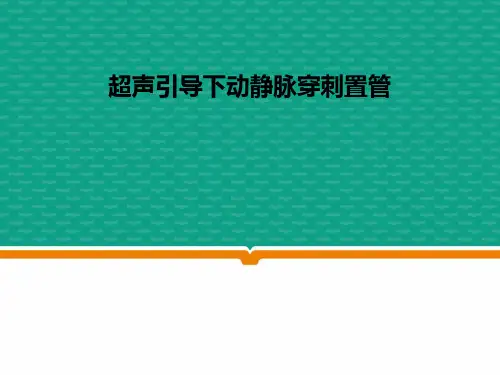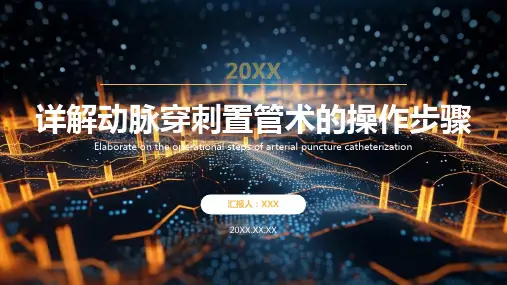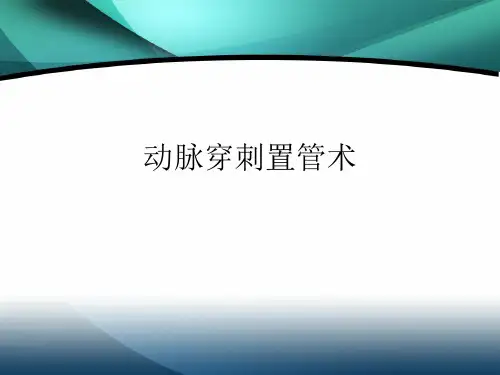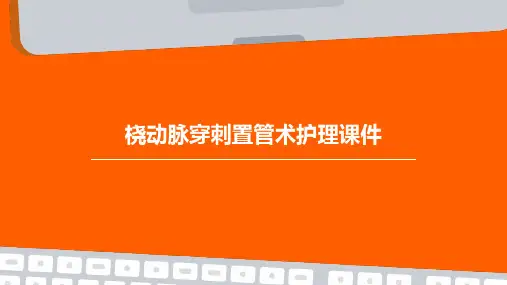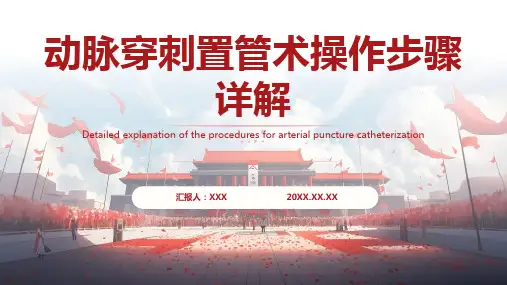在建立有创动脉 血压监测后,应严 格无菌操作,加强 穿刺点皮肤的护 理,每日用0.5% 碘伏消毒穿刺点, 并更换透明敷贴。
若有污染应及时 更换,保持局部清 洁干燥。
用肝素稀释液冲 洗测压管,可致患 者凝血时间、凝 血酶原时间和凝 血酶时间延长。 应加强观察穿刺 部位有无渗血!肿 胀等现象,对于老 年和肝肾功能不 良者尤其应注意 有无出血情况。
2、穿透法:进针点、进针方向和角度同上。当见有回血 时再向前推进0.5cm左右,后撤针芯,将套管缓慢后退 当出现喷血时停止退针,并立即将套管向前推进,送入 无阻力并且喷血说明穿刺成功。
精选ppt课件最新Biblioteka 10常见的问题及处理
*同一部位反复穿刺不成功 *穿刺针刺入桡动脉,穿刺针尾部血流不畅 *穿刺针回血良好,但送入导丝时阻力较大 *置入鞘管时阻力较大
精选ppt课件最新
2
冲洗装置
套管针穿刺成功后,连接冲洗装置,用肝素盐水以2-4mL/h的 速度连续冲洗管道,以防血细胞凝集阻管.冲洗液中肝素的浓度成 人为2-4U/mL,儿童为1-2U/mL为抵制动脉血反流,应向含肝素液 的塑料输液袋外加压至300mmHg(1mmHg=0.133kPa),而且由 于整个管道内充满肝素液,心动周期血液反流的机会更少,虽然冲 洗系统的压力可高达300mmHg,由于注速甚慢,与动脉导管尖端 的压力相差不超过2%,故不会影响血压的测量值。
精选ppt课件最新
5
【禁忌证】
• 局部感染 • 凝血功能障碍 • 动脉近端梗阻 • 雷诺现象 • 脉管炎 • Allen试验阳性
精选ppt课件最新
6
穿刺途径
• 常用桡动脉、足背动脉、股动脉,其次是尺动脉、肱动脉。 由于桡动脉(最常用左侧)部位表浅,侧支循环丰富,为 首选,其次为足背动脉和股动脉。股动脉较粗大,成功率 较高,但进针点必须在腹股沟韧带以下,以免误伤髂动脉 引起腹膜后血肿,足背动脉是股前动脉的延续,比较表浅 易摸到,成功率也较高。肱动脉在肘窝上方,肱二头肌内 侧可触及,但位置深,穿刺时易滑动,成功率低,并且侧 支循环少,一旦发生血栓、栓塞,可发生前臂缺血性损伤, 一般不用。
